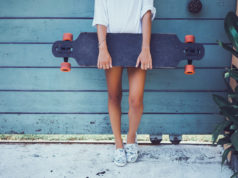As you get into longboarding, you’ll probably notice that longboards come in all different kinds of woods and combos of woods. Every board company is trying to outdo each other nowdays, so you may even see some exotics like KOA, Oak or Indian Rosewood that look rad, but may or may not support the rigors of your style of writing.
How Important Is It?
Now before I get into specifics, I wanted to address the question we get quite a bit: “Is the type of wood on your board important” The answer IMHO is yes it is.
Is it as important as descent trucks, wheels and the shape of your board: No. With ONE caveat: make sure that you’ve got enough thickness on your board, especially for your freestylers. This is typically measure by the number of ‘plys’ or layers of wood on the board you’re buying. If it’s got 3 flimsy plys, and looks like you could karate-chop it in half, you may want to question buying it.
Anyhoo, today’s post is on the TYPICAL woods used on 90% of longboards made today. Enjoy!
1. Maple
Maple usually ranges from 5 ply up to 10 ply (refers to layers of wood that are used in the construction process). It is the common wood used today in longboard skateboards. Longboards that are built with all maple get fairly heavy, which is why some other, lighter woods are mixed with the plys by some manufacturers.
Usually Maple Boards are made for going fast and downhill style boards. Depending on the shape and style of the board, maple boards usually will allow for sliding when there is any reverberation or chatter throughout the deck.
2. Bamboo
Bamboo boards are usually fairly light when compared with other boards that have additional layers and are made out of heavier, denser materials. Bamboo boards offer plenty of spring and flex. This is ideal for beginners since the board offers riders a lot of “forgiveness.” Good at absorbing cracks and bumps without the rider being thrown off.
This flex enables riders to lean harder and deeper into their board and allows the weight transfer to be absorbed by the board to make crisper and sharper turns (will also depend on how loose a rider sets his trucks).
Usually flexible boards like bamboo are intended for carving and cruising at lower speeds given that the board’s “springiness” can potentially cause the rider to get “death wobbles” when straight lining at a high speed. In addition, although bamboo boards may certainly be used for casual sliding, it is not recommended that a bamboo board be used if the riding style that is desired is mostly big hill sliding. The springiness of the bamboo board can cause some reverberation or chatter throughout the board and the slide can cause a very uneasy ride on downhill mountain journeys.
3. Birch
Birch usually ranges from 9 ply to 12 ply, and creates a board that is significantly heavier than a bamboo one, but somewhat lighter than a 5 to 8 ply maple board. Birch is quite unique in terms of being a mappy medium in between maple and bamboo. Birch boards offer a small amount of flex despite being stiff, making them versatile and able to achieve both bamboo and maple board abilities (as long as the rest of rider’s set is right, and has the correct wheels and trucks).
In general, Birch is usually less expensive than both bamboo and maples boards and anyone with a couple of tools can make one.
4. Carbon Fiber
The most expensive material of all that is used to make longboard skateboards is carbon fiber. Carbon fiber boards have a foam core to reduce the weight and are designed to help you with pushing off of the starting line more quickly and move around slides and turns effortlessly. Carbon fiber boards are ridden by most pro skaters.










